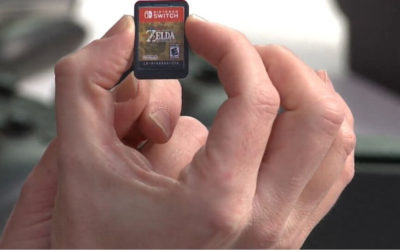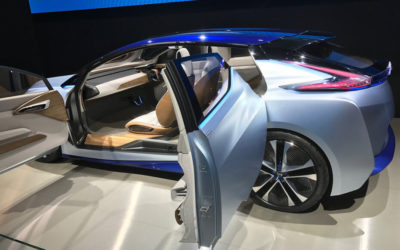Spaces gets another $6.5 million for its VR theme park dreams
Spaces gets another $6.5 million for its VR theme park dreams.
Image Credit: UploadVR Getting VR headsets into the casual user’s hands and households is one of the ongoing struggles of the industry.
Other than the mobile solutions, additional peripherals are not at consumer friendly price points yet and likely won’t be for a while, but there are events being held around the world and even some advertising and marketing opportunities that give people the chance to check things out.
Despite that reality, there’s one industry that has dabbled in VR for a long time and remains unafraid to invest in the technology as it evolves: theme parks.
We previously reported on a growing VR theme park initiative when Spaces Inc partnered with Songcheng Performance Development for a $30 million venture, and that mission is being furthered in a big way with additional funding.
The $6.5 million also includes contributions from companies like Boost VC, The Venture Reality Fund, and others that were part of the previous funding for Spaces so it’s clear that they continue to believe that a SPACES Inc-powered VR theme park will be a profitable idea.
“Together with our Songcheng joint venture, this new capital expands our efforts to create entirely new kinds of VR-enabled destinations.” There aren’t any details available to the public yet about what extent theme parks will be weaving virtual and mixed reality into attractions, but one of the new additions to the Spaces Inc board of directors paints an interesting picture for this program’s potential.
In addition to Michael Yang of Comcast and Songcheng’s Ethan Wang, Spaces Inc will be welcoming DreamWorks Animation CFO Fazal Merchant to the board.
Having a stronger relationship with the animators responsible for Shrek, How To Train Your Dragon, and Kung-Fu Panda doesn’t guarantee that licensed content from the production company will appear as part of VR attractions, but it could be a hint of them heading that direction.
This story originally appeared on Uploadvr.com.
How to make sure the future connected car is secure
Are connected cars secure?
As networks evolve to better meet the needs of IoT devices and connected cars, automakers must take extra measures to ensure appropriate levels of connectivity at each step of the vehicle’s life cycle.
Securing the connected car at each step of the vehicle’s life cycle Security must be a top priority — from designing the vehicle to the moment the driver takes the wheel and beyond – if automakers are to improve adoption rates and drive profits.
In addition to knowing when connectivity should be on or off, it’s also critical to know what a vehicle should be allowed to do with that connectivity at different stages throughout its life cycle.
Vehicle design: Auto manufacturers must ensure that the right technologies — such as in-vehicle routing, security, IoT connectivity, and more — are designed into the vehicle from day one.
OEMs must consider the types of services they want to enable throughout the life of the car, choose the right connectivity partner and management platform, and design features into the vehicle accordingly.
While vehicles are in shipping containers, manufacturers must be able to automatically disable connected services, while maintaining the ability to track vehicles during their journey.
During this time, security measures are needed to prevent theft, hijacking, or illicit remote control of vehicles.
Automated connectivity management platforms enable manufacturers to identify what vehicles are allowed to do with their connectivity.
Everyone — from the OEM to the dealership to the bank that enables automated payments to the developers of aftermarket services — must do their part to keep cars safe, consumers happy, and our “data centers on wheels” rolling securely.
The first self-driving bus on U.S. public streets is carrying passengers in Las Vegas
The first self-driving bus on U.S. public streets is carrying passengers in Las Vegas.
A small autonomous bus called an Arma is running a short route along Las Vegas’ Fremont Street, marking, according to transit operator Keolis, the first time a self-driving bus has moved passengers on an American public road.
And this is only a pilot test, which started on January 11th and will end January 20th.
The bus has sensors that detect obstacles and an emergency button that any passenger can use to stop the vehicle.
During the test, there’s also a staffer on board to monitor passenger safety.
The state has attracted the testing facilities for Hyperloop One, as well as Tesla’s new Gigafactory.
The Navya test is part of a push by Las Vegas to develop a downtown innovation district, where it also aims to test green energy and other technologies.
The state could benefit from easier long-distance transportation to gambling centers from California, while autonomous vehicles like the Navya bus could provide flexible transportation for visitors once they make it to Vegas.
This story originally appeared on Fortune.com.
Copyright 2017
Global IPO values set to grow by more than a quarter this year
Global IPO values set to grow by more than a quarter this year.
Global float activity is expected to rise by just over 25 per cent in 2017, before surging onwards in the following years.
This year will see floats reach $167bn (£138bn), according to experts at law firm Baker McKenzie, up from $133bn in 2016.
Further floats are expected to see activity dramatically uptick, reaching $275bn in 2018 and 2019.
“Improved market sentiment and a number of countries looking to list state-owned companies to raise money, particularly in the CEE (Central and Eastern Europe), CIS (Commonwealth of Independent States), Middle East and Africa should lead to a more benign market environment in 2017 with a real pick up towards the second half of the year into 2018,” said Koen Vanhaerents, global head of capital markets at Baker McKenzie.
Vanhaerents added that the technology sector will likely be a key source of activity, with a mooted Initial Public Offering for teen social media platform Snapchat likely to lead the way.
Read More: London set for biggest IPO in six years as warehouse giant plots 2017 float By contrast, acquisition activity is likely to remain diminished after slowing last year.
The law firm predicted total M&A values would droop from $2.8trn in 2016 to $2.5trn this year, before slowly recovering.
Baker McKenzie’s global head of M&A Michael DeFranco said volatility in the US stock market, growing concerns about China’s economic slowdown, and dropping oil and commodity prices caused dealmakers to become more cautious.
“We expect that environment of uncertainty to continue at least for the first quarter of this year,” DeFranco said.
Zuckerberg to testify in $2 billion lawsuit that claims Oculus used stolen technology
Zuckerberg to testify in $2 billion lawsuit that claims Oculus used stolen technology.
Facebook CEO Mark Zuckerberg will testify in court on Tuesday, January 17 for a potentially explosive lawsuit that claims the Oculus VR startup he acquired for $2 billion was based on stolen technology.
Zenimax is seeking $2 billion in damages against Facebook, which is the amount the social networking giant initially paid to buy Oculus in 2014.
Representatives for Zenmiax confirmed to Business Insider that Zuckerberg will take the stand on Tuesday, followed by Oculus cofounder Palmer Luckey later in the week.
The trial began on January 9; Oculus CTO and former Zenimax employee John Carmack was the first to testify on January 10.
Facebook tried to argue that Zuckerberg shouldn’t have to answer questions about his acquisition of Oculus, but the case’s judge overruled the request.
Luckey’s testimony will be his first public appearance since he admitted to secretly funding a political group that created anti-Hillary Clinton memes in September.
It claims that Carmack violated his employee agreement with Zenimax by sharing confidential information that Oculus then used as the basis for its VR software.
“Oculus and its founders have invested a wealth of time and money in VR because we believe it can fundamentally transform the way people interact and communicate,” an Oculus spokesperson told Business Insider.
Copyright 2017
Hearthstone’s Jade Golem mechanic used to be a lot different
Hearthstone’s Jade Golem mechanic used to be a lot different.
The first Jade Golem is a 1/1 minion, but the second one would be 2/2, then 3/3, and so on.
We had an idea early on that as you played jade cards, jade cards got better.
The very first version we had was — you had a jade count on your hero, and you had a bunch of cards that cared about your jade.
There was a card that summoned a 1/1 Jade Squirrel for each of your jade count.
As you played each of your jade cards, your count went up, and you made a bunch of squirrels and did a bunch of damage.
All these cards did different things, and your jade count meant different things in different spaces.
Then we said, what if you just made minions, and at five jade count this minion gets taunt?
The Jade Golem was a unifying part between the cards, and the actual card mechanic was what made them cool.
Do some damage and get a Jade Golem.
Intel believes 5G wireless could reach far beyond smartphones to smart things
I’ve spent 17 years at Intel.
You can start to utilize three, four, five gigabits per second in data rate and test different use cases with that.
We put a 5G FPGA-based modem in that platform that can now test any sort of—wherever there’s 5G spectrum available, you can test those use cases using upwards of seven gigabits per second.
You’re just seeing a lot of early advances in cellular because much of the network deployment and infrastructure—that work happens years before commercialization.
From a network standpoint, as you probably know, we provide solutions in network infrastructure as well — the core access network, the cloud.
Topol: You’ll see OEMs start to commercialize 5G solutions as early as next year.
But you can look at 2020 as the time when you’ll see major network operators and infrastructure partners fully deploying 5G capability.
He said, “Possibly, but what I’m concerned about is why the U.S. still has such expensive broadband relative to a lot of other places, and what you get for the price you pay.” Once you bring this all down and make this more competitive, a lot of other benefits accrue to consumers and businesses.
I just want to make sure that we can go out and support all these new business verticals.
When a partner comes in and says, “I want to test collaborative AR in a 5G environment,” we can bring all those assets together.
How I built and launched a personal finance chatbot in six months
This is a write-up covering the development of my startup, Teller, and the launch of our first pilot program with Brooklyn Cooperative.
I started building a chatbot back in January with the goal of developing something like a WebMD for personal finance questions.
At that time, I ran a Google survey to see where people got help with personal finance questions.
After a brief attempt at marketing my bot directly to users (B2C), I decided to change my focus a little.
If I could partner with a bank or credit union, I would get access to a large group of users who would benefit from using my messaging service.
It would also change the primary focus from finance education to banking customer service.
Last week, we launched a pilot that will allow Brooklyn Cooperative members to start communicating with the bank through text messaging.
For this pilot, I see three main parties involved: Brooklyn Cooperative Members: Members get instant answers to customer service questions and potentially discover a place to ask the other personal finance questions they didn’t know who to ask before.
Brooklyn Cooperative: The credit union is able to automate simple questions and provide an additional (and more scalable) resource for personal finance education.
Teller: We are able to facilitate and track the types of questions people are asking, and build a more robust database and script for the future One thing I took away from my time working at Facebook was the ‘rapid-testing’ approach to product development.
PAL Holdings plans re-IPO
PAL Holdings plans re-IPO.
MANILA, Philippines – PAL Holdings Inc. (PAL), tycoon Lucio Tan’s listed flagship airline company, is considering a re-IPO this year to beef up liquidity and raise capital that will support its planned investment program and future growth.
The planned re-IPO (initial public offering) comes almost 10 years since the company did a backdoor listing in 2007.
In a round table discussion with The Star, Tan’s son, Michael said the company is looking at how to go about the planned re-IPO.
A re-IPO is a follow-on offering on an already listed stock.
We need to choose an investment banker first to handle the process,” said the younger Tan, president of LT Group and PAL director.
PAL is acquiring Zuma as it consolidates its subsidiary Philippine Airlines Inc (PAI) and Zuma’s budget carrier Air Philippines Corp., in an arrangement valued at P8.24 billion as the tycoon rationalizes his airline businesses under a single parent company and within a single group of companies.
As it lures investors, the airline has embarked on a major fleet expansion program.
It expects 33 more airplanes until 2024.
PAL is also working closely with the government, specifically the Department of Tourism, Department of Transportation, Civil Aviation Authority of the Philippines and Manila International Airport Authority to provide passengers their desired experience.
Here’s a closer look at Nintendo Switch’s game cards
Video game tapes have shrunk a bit over the past 30 years.
To save the battery life in its upcoming Switch console, Nintendo is not using spinning discs like Blu-rays.
Instead, the hybrid handheld/home system will use a card-style medium similar to what the publisher used on the 3DS.
During a livestream from a media event in New York City today, Nintendo of America employees provided fans with a close-up view of what the company is calling Switch game cards.
Here’s a look at the back and front of The Legend of Zelda: Breath of the Wild for the Switch.
And these are game cards — not cartridges, which is what Nintendo used for the Nintendo Entertainment System, Super Nintendo, and Nintendo 64.
That’s an important distinction that I wrote about previously.
For one, these game cards are not that much more expensive to make than a Blu-ray disc, and they don’t take much longer to print.
At the same time, these cards can also store around as much data as a standard (non-dual layer) Blu-ray, but smaller games can use less metal.
And that will save publishers money when they only need about 8GB instead of 25GB.
5 Trump policies that could change the game for entrepreneurs and VCs
5 Trump policies that could change the game for entrepreneurs and VCs.
In particular, the new administration seems eager to simplify complex regulations and to advance initiatives to bring jobs and capital back from overseas.
For most early-stage growth companies, tax rates are less of a concern given typically high cash burn rates and carry-forward positions on their balance sheets.
Still, startups stand to be the benefactors of a wave of investment from larger companies if lower corporate tax rates pass.
Low-cost opportunities for cash repatriation Currently, companies holding cash overseas pay a 35 percent repatriation tax rate when they move earnings back into the US.
To avoid that high cost, many companies simply reinvest the money abroad instead of bringing it back.
For early stage growth companies, that would be very positive news.
Small companies have traditionally struggled more with interpreting legalities, so entrepreneurs and startups stand to gain from fewer and simpler requirements.
Entrepreneurs should remember that political risk needs to be monitored and managed.
The businesses that will gain the most are the ones whose leaders strategize in advance.
Russia’s New and Most Promising Entrepreneurs
Aksenov’s love of artificial intelligence and robotics began when he was a young boy.
Ilya Sachkov is CEO and Founder of Group IB: Global Cyber Security Company.
Leaving the army after 10 years of service, Pshegornitskiy was faced with making his own way in a crumbling economy that came on the heels of the collapse of the Soviet Union.
Fortunately, he had secured two degrees in electrical engineering from military school, and a degree in Economics from the University of Moscow while on active duty.
Dmitry Grishin is probably one of the most prolific entrepreneurs in Russia.
By 2012 he was able to launch Grishin Robotics with $25 million of his own funds.
Zenoviev took a job as a banker.
Around this time, the Russian economy was crashing again.
In 1999, with $200,000 from the investment fund he was managing, he opened Delta Leasing, one of the first leasing companies in Russia.
For Russian entrepreneurs, national challenges are merely global opportunities, as can be seen by these profiles and the many more than can be found by scanning business journals, such as Forbes, which features many successful Russian entrepreneurs and corporate leaders.
Before you start a company, answer these questions
Before you start a company, answer these questions.
Image Credit: alphaspirit / Shutterstock A few months ago, a friend called me excitedly to share a startup idea.
If he wasn’t passionate about solving this problem, he should pass on the idea.
Are there real customers for this?
It’s one thing to have a working product, it’s quite another to have paying customers.
Can you survive if your product doesn’t take off for 12-24 months?
Founder Collective’s advice for founders is to plan for a year with no income from the time you quit your job until the time you get funded.
Can you keep your day job until you’ve validated your market and you’re ready for lift off?
Spending more time on an idea won’t either.
I told my friend not to quit his day job.
7 highly connected cars you will drive in the future
7 highly connected cars you will drive in the future.
Cars that are much safer and reduce accidents.
This is what we can expect in the next few years as AI and machine learning hit the road (literally), helping us drive smarter and even offering to take over the driving for us entirely.
They will also sense when there is a crash ahead and re-route you in real time.
The Ford Fusion prototype has two LIDAR sensors for scanning the road (they are located near the windshield) and can drive autonomously.
Ford expects its self-driving tech to debut by 2021.
What separates this Hyundai from many other self-driving cars is that it is going to go into production soon — we even tested one at CES 2017.
The Ioniq is a new model that will come in three versions (electric, hybrid, and plug-in hybrid) this year, but the autonomous tech is also far enough along that we expect it to be an option in the Ioniq within the next few years.
The prototype has extra LIDAR sensors, radars, and cameras to assist with automated driving.
There are no set plans to make these prototypes available for production yet.
How to Say ‘No’ at Work (Infographic)
How to Say ‘No’ at Work (Infographic).
Whether you’re trying to impress your boss or you fear you’ll let someone down, saying “no” at work can be hard.
Too often, people burn themselves out by agreeing to take on more tasks than they can handle.
However, overloading yourself with work can reduce the quality of what you produce.
If you’re too busy, you may also miss deadlines.
In those cases, the person you’re working for likely would have preferred that you had just said “no” from the start.
Don’t feel bad or guilty about saying this two-letter word.
If you want to build a great career, you’ve got to get used to it.
There are plenty of perfectly good reasons to say no to someone — it’s just a matter of how you say it.
Check out Business Backer’s infographic below to learn how.
5 Things Sailing Around the World Has In Common With Startup Life
Since the day we set sail, I have started a new company, which has had a very successful launch recently.
I am working and communicating with my team members — situated in different parts of the world including Switzerland, Finland, Mauritius and Portugal — while sailing, on anchor or when in a marina.
Through this whole process of sailing with my family and starting a business at the same time, it occurred to me that there are indeed lessons from sailing that also apply to startups.
The compass and even the stars have thus been an important part for navigation for us.
The satellite phone and the pactor modem are most important for weather reports on high sea.
When it comes to the business world, especially when looking at the new company that I started, the team is using HipChat and Trello.
This is one of the most important lessons I have learned in life.
We didn’t have time to go to customs to check in, but we did go two days later.
But, I didn’t want to lie, so I told them the truth.
Having that ability to troubleshoot and find solutions to problems is a critical skill set to have as a sailor and as an entrepreneur.
Matrix Partners China leads $8m financing in parenting startup Niangao-mama
Niangao-mama, an online parenting startup bagged a RMB$60 million (US$8 million) investment, and the round was led by its existing investor, the Chinese arm of US venture capital firm, Matrix Partners China, and it also included Ziniu Fund, a RMB angel investment firm.
The news was first reported by China Money Network, which also said that Matrix Partners China was an existing investor in the company, and had provided Niangao-mama with seed funding as well as Series A investment.
Founded in 2015, Hangzhou-based Niangao-mama is a platform that has created a broad network of maternity and childcare communities with quality content.
The latest funding round will help the company develop their “supply chain and products improvement,” the news report quoted it as stating.
Matrix Partners China invests in seed-stage, angel, early stage as well as late stage companies, focusing on communications, digital media, Internet, healthcare, cleantech and consumer related businesses.
Back in 2011, it had raised $350 million for its second China fund – Matrix Partners China II – and during the same year, it had also raised $300 million for its second vehicle in India – Matrix Partners India-II.
In 2014, it had raised another $350 million for its third China fund.
Last year, Matrix Partners had raised raised $500 million for its fourth Chinese vehicle.
Software developer, Cheetah Mobile is also one of its portfolio companies in China.
Also Read: China’s MobileMD System raises $14m led by Genesis Capital HK-based Klook Travel raises $5m from Matrix Partners, China Growth Capital; to expand to Singapore Remaking Matrix Partners India after co-founder Rishi Navani’s exit
The impact of machine learning on the customer experience
The impact of machine learning on the customer experience.
The major advancements in readily accessible computing power, the quantity of data available and algorithms that truly make machine learning possible are driving the ability to process data, analyze it and act on it in ways that would make Mr. Turing proud.
The rise of programmatic customer experiences To get a sense of the potential impact of machine learning on customer experience, you only need to look as far as the arrival of programmatic advertising a few years ago.
This completely revolutionized how ads are bought and targeted online, harnessing data to not only automate a lot of the “grunt” work, but also to make much smarter, more strategic decisions about where the opportunities for brands lie.
In the same way, harnessing machine learning for programmatic customer experience has enabled marketers to identify clear customer segments and target them in ways that they know will resonate.
This more complete customer profile now allows the retailer to offer a more high-end shoe, informing the customer that these shoes have won more marathons than any other.
Machine learning plus better customer data allows you to build a far better and more personal experience for each customer.
As customers become more demanding, expect more and become less willing to sympathize with experiences that miss the mark, they’re trusting brands less to provide a good experience and cutting out the ones who don’t.
It is true that this generation is driving the demand for hyper-personal sophisticated experiences.
With the right approach to data, machine learning can completely change the customer experience game.


















